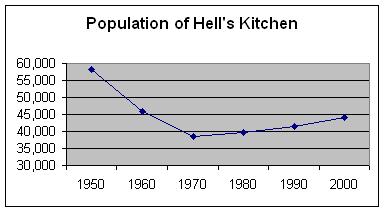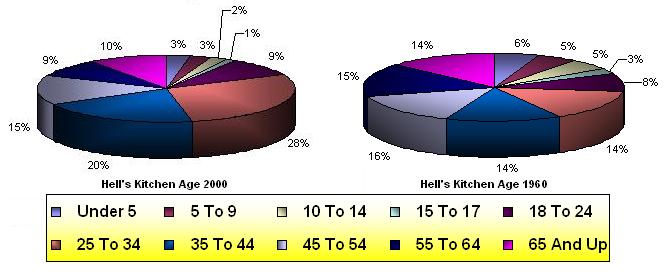Hell's Kitchen Demographics
From The Peopling of NYC
Hell's Kitchen is comprised of census tracts 111, 115, 117, 121, 127, 129, 133, 135, and 139.
Contents |
Population
Hell's Kitchen has 43,983 residents as of the 2000 census with a population density of 63,312 per square mile, leaving the total area of the neighborhood at about 0.7 square miles. The population has slowly crept up in the past few decades since its nickname has been phased out of realtor's language. In 1950 the population was at 58,278 which declined to a low of 38,557 in 1970. All in all the population never shifted very much. Likely this was due to the massive flow of residents which initially saturated the housing market. The low income residences kept the occupancy rate consistently above 90%. Coupled with the low-rise architecture of the neighborhood restricting upward expansion, its clear that the population was never situated for fluctuation. The initial drop of almost 20,000 may be attributed to the increasing ease of transportation as the subway system continues to grow.
Age
In the past two decades, Hell's Kitchen has seen a significant increase in the age group of 25 to 34 year olds. It is a recent phenomena without any clear explanation. A significant portion of this increase appears to be from recent college graduates, as over 50% of the population over the age of 25 has a college degree.
Race
Although the stories of the diversity of Hell's Kitchen have become iconic of Hell's Kitchen, it seems that the census data disagrees. Since the 50's there has been a clear majority of white residents. Over time the population has constantly shifted away from that majority, but it still stands at approximately 60%. The lack of cohesion behind the mythology of Hell's Kitchen and the data is initially confounding, but it is likely more a fault of the data collection than a complete over exaggeration of the facts by popular media. Census data going back beyond the 70's tends to treat race under the big three of white, black, and other. It is difficult then to track things so as the large flow of immigrants from Puerto Rico during the 50's, and the ensuing gang conflicts immortalized by the musical West Side Story. Current data contained an amalgam of details, and in aggregating them to the big three the resultant comparisons become questionable.
Income
Here we see the simple impact of gentrification. The poorest pushed out, and the wealthier move in. The average income of Hell's Kitchen has seen obscene growth over the last several decades, jumping over $20,000 from 1990 to 2000. Keep in mind that all those numbers have been adjusted for inflation to 1999 standards, so what you see is a severe increase in the average residents income. Certainly we aren't seeing the truly wealthy take a interest in Hell's Kitchen, or Clinton as they would likely call it, but there's no denying the changing face of the residents, or at least their wallets.
Marriage
Marriage is Hell's Kitchen is following the larger trend of America, which is to say they are failing more and more often. Divorce percentages are up, and the number of people currently married has declined in the last half century. Another contributor however in recent years to the number of residents who never married is the growing gay community present in Hell's Kitchen. The most important factor however may be the neighborhood's recent trait of being a transitional home. Generally low rent housing invites fresh adults working their first job to take up residence until their situation his improved, at which time they are likely to move. Particularly attracted to the low pricing are aspiring actors. The combination of relatively low priced housing and proximity to Broadway makes living here a great commodity to a Hollywood hopeful.
back to Hell's Kitchen




